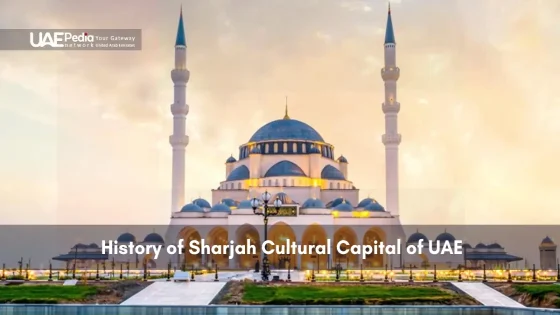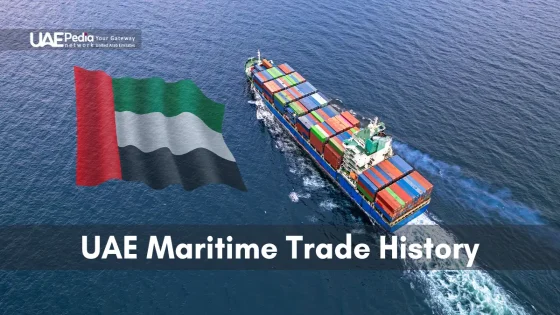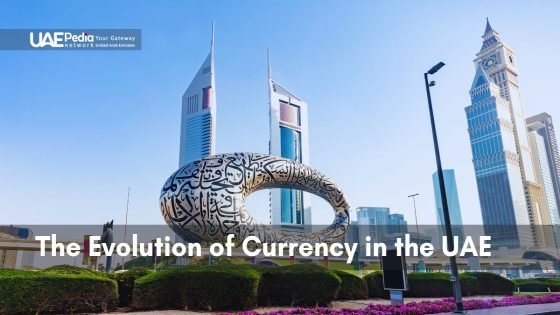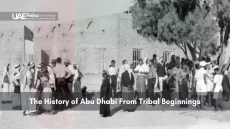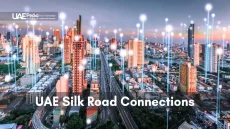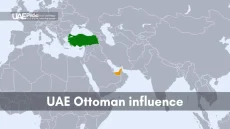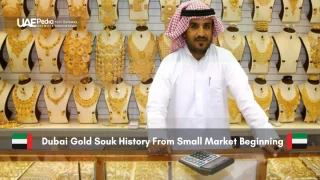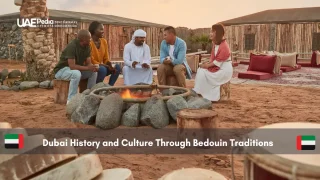What if we told you this desert jewel once thrived on pearls instead of petroleum? Long before skyscrapers pierced the sky, coastal communities here built their lives around the sea’s treasures—a story best understood through the vibrant lens of Hindi narratives.
Archaeologists have uncovered stone tools near Jebel Hafeet that whisper of settlements dating back 7,000 years. Families gathered around fires under star-filled skies, their lives shaped by trade routes connecting Mesopotamia to Oman. The salty breeze carried more than seabird calls—it brought dhows laden with pearls harvested from the Gulf’s depths.
By the 18th century, the Al Nahyan family began unifying tribal groups into what would become a global powerhouse. British treaties in 1892 opened new chapters, but the true turning point came with the discovery of “black gold” in 1958. Today’s gleaming towers stand where Bedouin tents once fluttered in the shamal winds.
Quick insights:
- Coastal origins shaped by pearl diving and ancient trade networks
- Strategic alliances that forged modern governance structures
- Cultural continuity preserved through oral histories and traditions
This evolution from fishing villages to the capital of the united arab emirates reveals how vision and heritage can coexist—a journey we’ll unpack through rare photos and firsthand accounts.
Ancient Roots and Early Settlements
Imagine walking where ancient traders once bartered copper for pearls—long before luxury hotels dotted the coastline. Beneath today’s bustling streets lie whispers of civilizations that thrived here millennia ago.
Archaeological Finds and Early Habitations
Digs near Jebel Hafeet reveal pottery shards and stone tombs from 5,000 years ago. At Umm al Nar, circular graves tell stories of Bronze Age communities trading with Mesopotamia. These sites prove the region wasn’t just a desert crossroads—it was a cultural melting pot.
Nomadic Lifestyles and Fisher Communities
Families moved with seasonal rains, herding camels and goats across dunes. Coastal clans crafted boats from palm wood to harvest fish and pearls. As one archaeologist notes: “Their survival depended on reading stars and tides—skills still honored today.”
You’ll find echoes of this resilience in modern markets where fishermen mend nets beside skyscrapers. The united arab spirit—rooted in adaptation—shines through in traditions preserved across generations.
Tribal Legacies and the Birth of a Nation
Centuries ago, a nomadic tribe’s decision to settle by the coast would unknowingly lay the groundwork for a global hub. The Bani Yas Bedouin—skilled navigators of both desert and diplomacy—shifted their base to the Arabian Gulf shores, blending maritime savvy with tribal unity.
Bani Yas Bedouin and the Al Nahyan Dynasty
When the Bani Yas relocated in the 1790s, they didn’t just find water—they discovered opportunity. Their new coastal home became a strategic anchor for trade and governance. As one elder recalls: “We carried our traditions like precious cargo, planting them where the sand meets the sea.”
The Al Nahyan family emerged as unifying leaders, fostering alliances that turned scattered tribes into a cohesive force. Their leadership style—equal parts pragmatism and vision—still shapes decision-making today. Check how traditional values meet modern governance:
| Traditional Tribal Value | Modern Application |
|---|---|
| Consensus-building (Shura) | Collaborative policy development |
| Resource sharing | Economic diversification programs |
| Hospitality | Global tourism initiatives |
This dynasty’s legacy isn’t locked in museums—it lives in the arab emirates’ stable growth and cultural festivals celebrating camel racing and falconry. Next time you stroll along the Corniche, remember: those sweeping views stand on foundations of tribal trust forged under endless desert skies.
The Impact of Pearling and Early Trade Routes
Before oil rigs dotted the horizon, shimmering oyster beds ruled these waters. Divers plunged deep without oxygen tanks, gripping nose clips made from camel bone as they harvested nature’s treasures. Their catch—lustrous pearls—became currency long before dirhams existed.
Pearling Industry and Maritime Trade
Entire villages revolved around pearl seasons. Boys as young as 12 trained to hold their breath for two minutes, filling woven baskets with oysters. A single perfect pearl could feed a family for months. By the 19th century, over 1,200 ships sailed from the Gulf annually—their cargo funding markets, homes, and alliances.
British records show how these gems reached European royalty. One merchant journal notes: “Our Arab partners knew each oyster’s worth like their children’s names.” This expertise built trust that later eased oil negotiations.
Strategic Positioning in the Gulf
Sitting where the Gulf narrows, the emirate became a maritime crossroads. Dhows from India and Persia docked beside Bedouin traders swapping dates for spices. Check how geography shaped prosperity:
| Historical Advantage | Modern Parallel |
|---|---|
| Natural deep-water harbors | World-class ports like Khalifa |
| Monsoon wind patterns | Global shipping lane access |
| Pearl quality control systems | Luxury brand partnerships |
When Japanese cultured pearls flooded markets in the 1930s, locals adapted—proving resilience that fuels today’s diversified economy. Next time you admire the Louvre’s dome, remember: its curves mirror oyster shells that once bankrolled a nation’s rise.
History of Abu Dhabi in Hindi: Tribes, Trade, and Transformation
Picture this: a dusty outpost where camel caravans once traded spices now hosts global summits under neon-lit towers. The shift from tribal councils to federal governance didn’t happen overnight—it’s a saga of calculated risks and cultural pride that Hindi chronicles capture vividly.
Unraveling Abu Dhabi’s Past in Hindi
Hindi narratives reveal how Bedouin elders used moon cycles to time pearl harvests—knowledge later applied to oil exploration schedules. One merchant’s diary from the 1930s notes: “We measured wealth in baskets of oysters before learning to count barrels.” This blend of tradition and adaptation fuels the region’s identity.
| Traditional Practice | Modern Equivalent |
|---|---|
| Pearl diving seasons | Year-round oil exports |
| Desert trade routes | Global shipping lanes |
| Tribal resource sharing | Economic diversification |
Key Historical Milestones
Three game-changers reshaped the landscape:
- 1958: Oil discovery turned tidal flats into economic engines—revenue jumped 3,000% in a decade
- 1971: Formation of the united arab emirates created a stable platform for growth
- 2000s: Smart-city initiatives attracted tech giants and luxury travelers alike
As Sheikh Zayed famously declared: “Our ancestors crossed deserts without maps—we’ll build futures without limits.” From souks to stock markets, every innovation honors roots while reaching skyward. Want the full story? Hindi archives await your curiosity.
Architectural and Cultural Evolution
Step into a city where wind towers cast shadows on glass giants—a skyline stitching together centuries of design wisdom. Abu Dhabi’s structures whisper tales of Bedouin ingenuity while winking at tomorrow’s possibilities.
From Traditional Forts to Modern Skylines
Qasr Al Hosn’s sunbaked walls—built in 1761—still guard memories of pearl traders and royal councils. Just 15 km away, Etihad Towers’ mirrored surfaces reflect cloud patterns like liquid mercury. This contrast isn’t accidental. Architects blend desert motifs with futuristic lines: lattice screens inspired by mashrabiya adorn steel high-rises, while underground parking mimics ancient falaj irrigation channels.
Cultural Landmarks and Heritage Sites
The Sheikh Zayed Grand Mosque’s 82 domes glow like full moons, their marble inlay work taking 1,500 artisans a decade to complete. At Heritage Village, you’ll find date presses beside VR headsets showing 3D recreations of lost settlements. Restoration teams use laser scans to preserve crumbling watchtowers—then install solar panels matching their original silhouette.
Three ways tradition meets innovation:
- Al Jahili Fort’s new visitor center uses geothermal cooling like its 1890s design
- Louvre Abu Dhabi’s dome creates “rain of light” patterns seen in oasis palm groves
- Saadiyat Island’s museums embed Arabic calligraphy into AI-powered exhibits
As a local architect told us: “We build forward by first digging deep.” Wander Corniche Road at sunset—where dhows bob beside neon-lit yachts—and you’ll feel the arab emirates’ heartbeat: proud of its roots, racing toward horizons.
Economic Transformation: From Oil Discovery to Global Diversification
Think of an economy that moonlights as a shapeshifter—one moment fueled by black gold, the next powered by cultural magnetism. That’s the story of this Gulf powerhouse. When drillers struck oil in 1958, they tapped into more than crude—they unleashed a blueprint for reinvention.
Oil & Gas: The Economic Backbone
ADNOC’s first exports in 1962 didn’t just fill coffers—they funded schools, hospitals, and highways. By 1971, the emirate pumped 1 million barrels daily. “We treated oil like a guest,” a retired engineer told us. “Welcome it, but never depend solely on its company.”
Expansion into Tourism and Financial Services
Skyscrapers now duel with desert horizons. Yas Island’s Ferrari World races alongside Louvre Abu Dhabi’s art—a $30 billion tourism push. Banks flock to ADGM’s tax-free zone, managing $625 billion in assets. The maritime trade heritage that once moved pearls now fuels global finance.
Three smart pivots define the strategy:
- Masdar City’s solar farms powering 20,000 homes
- Etihad Rail connecting all seven emirates by 2024
- Ghadan 21’s $13.6 billion booster for tech startups
“Diversification isn’t Plan B—it’s how we honor our past while building futures,” explains a government strategist.
From desert to diversified dynamo, the journey proves one truth: vision outlasts oil reserves. Next stop? A knowledge economy where AI tutors work beside camel trainers—because here, tradition and innovation aren’t rivals. They’re dance partners.
Modern Developments, Cultural Fusion, and Global Influence
Where desert sands meet silicon chips, Abu Dhabi crafts tomorrow’s blueprint. Glass towers rise beside heritage sites, their reflections dancing on AI-monitored irrigation systems. This isn’t just urban growth—it’s a masterclass in balancing Bedouin wisdom with 21st-century ambition.
Technological Advancements and Urban Growth
Driverless pods glide past date palm groves in Masdar City, a zero-carbon district powered by 87,777 solar panels. Across town, AI analyzes traffic patterns through cameras shaped like falcon eyes—a nod to tradition. The skyline’s latest star, the 382-meter Aldar HQ, mimics a giant oyster shell, blending maritime heritage with cutting-edge engineering.
Global Partnerships and Innovation
When the Louvre opened its Gulf branch, it didn’t just display art—it sparked a cultural bridge. Over 600 global firms now call Abu Dhabi Global Market home, drawn by tax incentives and “innovation visas” for tech pioneers. The emirate’s renewable energy partnerships span 30 countries, proving sustainability isn’t solitary work.
Three ways tradition fuels progress:
- Smart mosques with app-controlled AC and digital donation boxes
- Date farms using drones and ancestral water-saving techniques
- VR tours of Qasr Al Hosn paired with holographic storytellers
“We’re coding the future in Arabic,” says a tech hub director. “Every algorithm respects our roots.”
From bustling souks to futuristic theme parks, the united arab spirit thrives. Here, 3D-printed museums share sidewalks with camel milk cafes—proof that honoring the past doesn’t mean slowing down.
Reflections on Abu Dhabi’s Enduring Legacy
Trace the arc of a city that turned tides into towers—where ancestral wisdom fuels tomorrow’s blueprints. From pearl divers charting star paths to architects coding smart cities, this land thrives on reinvention without forgetting its roots.
The Al Nahyan vision transformed Bedouin resourcefulness into global leadership. Tribal values of consensus and hospitality now shape policies attracting Fortune 500 companies. You’ll taste this fusion in spice-scented souks buzzing with digital payment apps.
abu dhabi’s skyline mirrors its soul: Qasr Al Hosn’s weathered walls stand firm as glass titans rise. The united arab emirates’ capital proves traditions aren’t relics—they’re launchpads. Falconry meets AI here, each generation adding layers to an ever-evolving story.
Walk palm-shaded corniches where elders share tales under fractal-patterned bridges. Dive into museums where holograms recount pearl harvests beside oil era documentaries. Every corner whispers, “Look how far we’ve come—imagine where we’ll go.”
Ready to explore living history? Pack curiosity alongside sunscreen. This desert phoenix awaits—its past your compass, its future an open horizon.
Archaeologists have uncovered stone tools, burial sites, and ancient settlements on Marawah Island dating back 8,000 years. These finds reveal thriving fisher-hunter communities who adapted to coastal life long before skyscrapers rose.
The Bani Yas Bedouin—led by the Al Nahyan family since the 1700s—transformed Abu Dhabi from a pearl-fishing village into a strategic Gulf power. Their legacy lives on in traditions like falconry, camel racing, and desert hospitality.
Before oil, pearling fueled trade across the Gulf and Indian Ocean. Divers risked everything for “white gold,” creating a maritime culture visible today in the dhow boats at Heritage Village and the Qasr Al Hosn fort’s pearling exhibits.
The 1958 oil strike catapulted Abu Dhabi from a quiet desert emirate to an energy powerhouse. Revenue funded infrastructure, healthcare, and education—laying foundations for today’s diversified economy in finance, tourism, and renewable energy.
Contrast the 18th-century Qasr Al Hosn fort with the Louvre Abu Dhabi’s modern art. Wander the Al Ain Oasis (a UNESCO site), then marvel at the Sheikh Zayed Grand Mosque—where heritage and ambition meet in marble and gold.
While our guide focuses on English content, the Abu Dhabi Culture Department offers multilingual materials. Check their website for Hindi documentaries on Bedouin traditions, trade routes, and the Al Nahyan dynasty’s rise.
From AI-powered farms in Al Ain to Masdar City’s renewable energy labs, the emirate invests in tomorrow while preserving heritage. Annual festivals like Al Dhafra Camel Festival prove Bedouin roots remain central to its soul.

